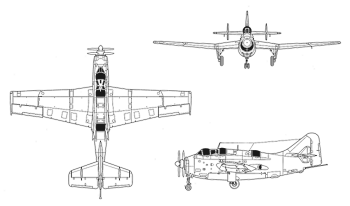



The Fairey Gannet arose from a 1945 specification for a Royal Navy aircraft capable of combining the anti-submarine hunter/killer roles which has previously been performed separately (one plane 'hunting' with another 'killing' the sub). The Gannet's most notable feature was an Armstrong Siddeley Double Mamba turboprop which featured coupled Mamba enignes and co-axial counter-rotating propellers (one engine could even be shut down in flight). It was also the first British carrier aircraft which could carry its entire payload internally, these usually comprised torpedoes, depth charges or bombs, in addition to underwing rockets. The Gannet became the Royal Navy's principal ASW aircraft during the 1950s and 1960 and served as an airborne early warning platform until the retiring of the last conventional carrier in 1978. Other users of this fine yet underrated aircraft included Australia, Germany, and Indonesia.
First flight of the prototype Gannet took place on 19 September 1949 after winning a production contract against a rival Blackburn design. It entered service as the Gannet AS.1 in 1953 and later as the improved AS.4 with upgraded engines and equipment. Some were later given new avionics and were known as the AS.6 while other versions included the T.2 and T.5 trainers (based on the AS.1 and AS.4 respectively) as well as the AEW.3 early warning platform with a large radome housing an APS-20 search radar. These were the last conventional fixed-wing aircraft to enter service with the Royal Navy.
Preceded by:
NoneSucceeded by:
None | |
| Design | Gannet AS.4 |
| Type | Anti-Submarine |
| Year | 1955 |
| Crew | 3 |
| Dimensions | |
| Length | 13.11 m |
| Height | 4.178 m |
| Wing Span | 16.56 m |
| Wing Area | n/a |
| Weight | |
| Empty | 6,382 kg |
| Maximum | 10,210 kg |
| Wing Loading | 227.5 kg/m² |
| Performance | |
| Speed | 483 km/h |
| Ceiling | 7,620 m |
| Range | 1,065 km |
| Powerplant | |
| Engine | 1 x Double Mamba 101 Armstrong Siddeley 2,263 kW |
| Thrust/Weight | 0.43 |
| Armament | |
| Guns | - |
| Payload | 907 kg |
| Production | |
| Built | 75 |
| Total | 349 |